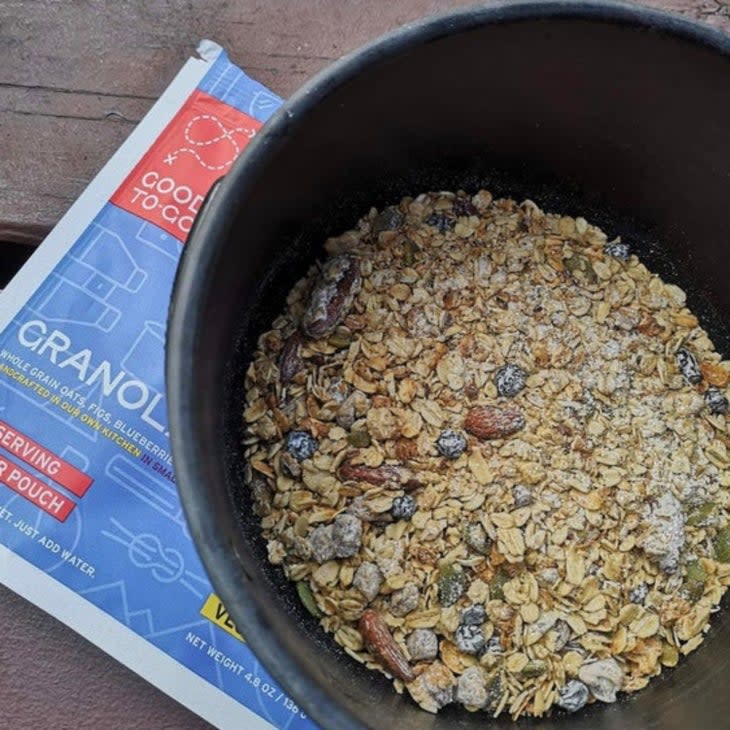Field Tested: Good To-Go Meals, a Lightweight Climbing Food
This article originally appeared on Outside
Basics
Good To-Go's dehydrated meals are flavorful, lightweight, and nourishing, with easy-to-pronounce ingredients. All of their meals are gluten-free and are primarily vegan and vegetarian. The meals have a maximum five-year lifespan, are packaged in a durable plastic bag, and require boiling water to prepare.
Pros
No preservatives // Real, recognizable ingredients // Durable packaging // Dehydrating food is less energy intensive than freeze-drying // Delicious
Packaging is not recyclable // Relatively short shelf life--5 years compared to ~25 for freeze-dried foods // Slower to rehydrate and slightly heavier than freeze-dried foods
Our Thoughts
Good To-Go is a worthy option for overnight climbers and campers who want to eat real food with a finite lifespan. The company's celebrated chefs are on display at each meal, with offerings ranging from spicy Korean bibimbap to hearty Mexican quinoa bowls, providing 13 different entrees that accommodate a range of ethnicities, taste preferences, and dietary restrictions.
When I first began reading up on "backpacking meals," as a minimum-wage-earning high-school graduate, my overnight alpine food was little different from what I ate at home: pre-seasoned rice, macaroni and cheese, and baked beans. The cheap food fit my cheap lifestyle, my impatience for cooking, and, most importantly, my utter indifference to nutrition. This "diet"--if such a term can be used here--served me well for the first several years of my alpine-climbing life: I'd slam as much processed food as my budget would allow, climb a long 5.7-or-so ridge, and drink Alberta Premium back at the car.
As time went on, however, I began to want more output from my body. And my body, in turn, wanted more from me. It wanted vegetables. And protein. And a lighter backpack that didn't hold a glass jar of tomato sauce and tin cans of baked beans. (There was a summer when I subsisted almost entirely on expired military rations, lightening my pack and saving money, but my digestive system is still recovering from that one.)
These days, having learned the importance of nutrition and recovery, I've been reaching for Good To-Go's meals for overnight trips where I need lightweight, nutritious food that I look forward to eating. Sorry, Spam, we were bound to grow apart.

Good To-Go is headed up by Jennifer Scism, a professional chef of 20-plus years, graduate of Manhattan's French Culinary Institute, and, in 2005, winner of the TV Food Network's Iron Chef program. Scism and I exist at opposite ends of the culinary spectrum (or did at one time) but I can wholly appreciate the effort her team puts into these dehydrated meals. Each of the five meals I ate--bibimbap, mushroom risotto, quinoa bowl, oatmeal, and granola--were thoughtfully flavored, nutrient dense, and preservative free. (The most difficult-to-pronounce ingredient was quinoa!)
Good To-Go's meals are handmade in small batches in Kittery, Maine, where they've opted to dehydrate their meals instead of freeze drying them like most big-name brands (Backpacker's Pantry, Alpine Aire, Mountain House, etc.). The main benefit of this: dehydrating food requires less energy than freeze drying it, making for a lower carbon impact. The main counterpoint to this debate is that dehydrating food sucks out its nutrients--and it's a worthy concern, too. However, Good To-Go brings all of their meals to 165 deg F for several carefully measured seconds, to ensure shelf stability, without reducing nutritional value.
Taste
Before Good To-Go, I've never once bought freeze-dried or dehydrated food for the flavor. I've lived the good life, remember? Expired ravioli in an "impact-proof" military baggie, electrolyte drinks lovingly named "orange beverage," the rare on-brand Pop-Tart.... But now? I am actually excited to tuck in for dinner. The mushroom risotto, well-balanced with basil, walnuts, and white wine, was a satisfying finish to a full day of steep quartzite sport climbing. The next day began with a hearty oatmeal (standout flavors included Zante currants, pumpkin seeds, banana flakes, and cinnamon) and ended with the bibimbap: a spicy yet sweet mixed rice dish with sesame, Gochugaru (a Korean red chile pepper), shiitake mushrooms, and brown sugar. Indeed, I went to sleep that night a happy camper.
Final Thoughts
When shopping for your next lightweight backcountry meal, there are a few drawbacks to dehydrated foods to keep in mind--namely, they are slightly slower to rehydrate than freeze-dried meals. (The average entree took about 20 minutes to fully cook, compared to the 10-15 minutes of several freeze-dried brands.) While cooking Good To-Go, I found that the water had to be boiling before dumping it into the pouch--not a moment sooner--for that cooking time to ring true.
Dehydrated foods also have a shorter shelf life than freeze-dried options--some freeze-dried brands boast a 25-year lifespan!--while Good To-Go maxes out at five. This may not be important for most climbers (just go shopping every five years?) and Good To-Go believes this to be a plus. As their website says, "We do not use preservatives in our meals. We believe firmly that real food cannot and should not endure 'til the end of time!" I tend to agree.
Originally published in Climbing Magazine.
For exclusive access to all of our fitness, gear, adventure, and travel stories, plus discounts on trips, events, and gear, sign up for Outside+ today.

